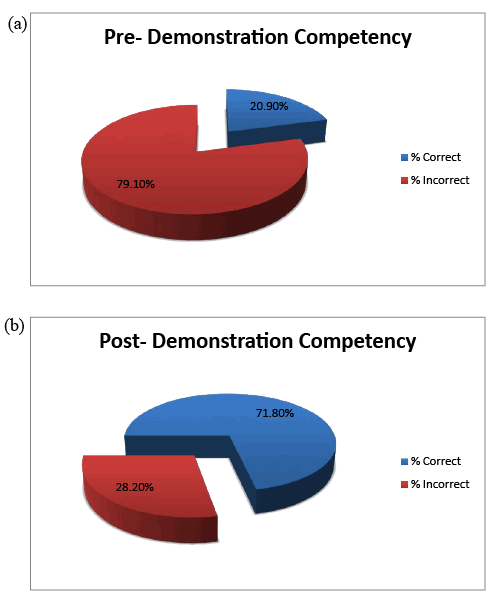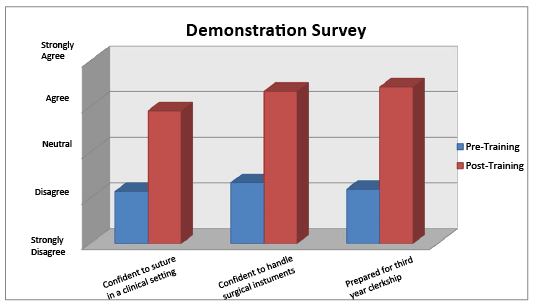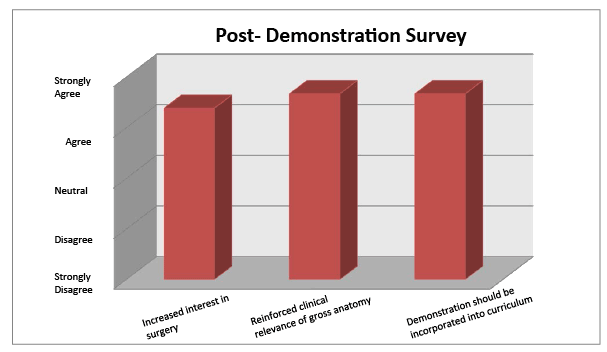
Figure 1: Pre and post-course competency exam utilized to assess surgical knowledge, skills, and degree of confidence in a surgical setting.

Vicki Sharma1* Christopher Surek2 Haley Stewart3 Robert Stephens 1 Barth Wright1 Julie Vircks4 Erich Wessel5
1Kansas City University of Medicine and Biosciences, Division of Clinical Anatomy, 1750 Independence Avenue, Kansas City, MO 64106, USA*Corresponding author: Vicki Sharma, Kansas City University of Medicine and Biosciences, Division of Clinical Anatomy, 1750 Independence Avenue, Kansas City, MO 64106, USA, Tel: (816) 654-7543; E-mail: vsharma@KCUMB.edu
Introduction: Current literature indicates that medical students lack competency and understanding of basic surgical principles when entering clinical rotations. Studies show early surgical exposure can improve student competence and confidence upon entering surgical clerkships. The purpose of this study is to create early exposure to routine operative procedures, surgical anatomy and dissection planes before entering surgical clerkships.
Methods: Twenty-one pre-clinical medical students interested in pursuing surgical careers were selected to participate in this study. The course consisted of 3 educational presentations followed by a surgical procedure. The procedures, led by surgical residents, consisted of a skin cancer resection with adjacent tissue flap closure, hysterectomy, and cholecystectomy. All students completed a pre- and post-study competency exam of surgical anatomy and surveys to determine confidence levels with surgical skills. Basic statistics were utilized to evaluate the data.
Results: An overall 51% improvement in knowledge of surgical anatomy was shown in the competency exam. In the pre-survey 90% (n=19) reported lack of confidence in suturing and preparedness for clerkships. In the post-survey 95% (n=20) reported confidence in these areas. Also, in the pre-survey 76% (n=16) felt unprepared to handle surgical tools while assisting in surgery. However, post-survey all students reported confidence. All students indicated that the experience reinforced the surgical relevance of gross anatomy and encouraged incorporation of the study into the curriculum.
Conclusion: This study improved confidence in pre-clinical medical students understanding of surgical anatomy and basic surgical skills. This may enhance learning and improve performance during surgical clerkships.
Education; Surgery; Anatomy; Medical students; Pre-clinical medical curriculum
Although many medical schools have interactive gross anatomy dissection labs, classical dissection does not use surgical approaches to relevant anatomical structures. As such these labs may not prepare medical students for surgical clerkships. Also, many medical students lack knowledge in basic surgical procedural skills as they enter clinical clerkships [1]. Sanders et al. [2] reported that only 50% of medical schools are achieving the objectives stated in the Medical School Objective Report, which proposed minimum routine technical procedures before graduating medical school. Liddelet al. [1] concluded that in the early stages of medical education, even a single formalized training session in basic surgical skills improved student competence and confidence. Other studies have reported that early exposure to surgical skills during preclinical years provide a higher level of comprehension and understanding of anatomical relationships on clinical rotations [3-5]. However, there have been very few courses that have been designed to incorporate these findings into the medical school curriculum [3,6]. The purpose of this study is to determine whether pre-clinical exposure to surgical anatomy, common operative procedures and dissection planes will improve preparedness for surgical clerkships.
The study consisted of twenty-one medical students in the semester preceding their third year of clinical clerkships. The students were all members of the Surgery or OB/GYN student organizations and their participation was completely voluntary. Immediately prior to the study the students took a pre-competency examination of common questions asked during surgical rotations or on shelf board exams (Figure 1). The students also took a pre-demonstration survey to determine their familiarity and comprehension of surgical anatomy, handling of surgical instruments, and procedural technique (Figure 1). Students were taught how to properly gown and glove prior to entering the surgical field. The study was composed of three approximately 45 minute sessions. Each session began with a short educational presentation, followed by a surgical procedure performed on a fresh, unembalmed cadaver. A fifth year plastic surgery resident performed a skin cancer resection with adjacent tissue flap closure on the face. He also addressed proper suturing and knot tying skills. A fourth year resident in OB/GYN performed an open hysterectomy after reviewing pelvic anatomy. A third year general surgery resident demonstrated both laparoscopic and open approaches for a cholecystectomy. The students completed the post-competency examination and post- demonstration survey upon completion of the three sessions (Figure 1). Basic statistics were utilized to evaluate the data obtained in the study.

Figure 1: Pre and post-course competency exam utilized to assess surgical knowledge, skills, and degree of confidence in a surgical setting.
All 21 students (100%) completed both the pre and post competency exam. The first four questions focused on gynecological anatomy often seen or referenced to while on an OB/GYN rotation. The students answered 20.2% (n=17) of the pelvic anatomy questions correctly prior to the hysterectomy demonstration, and 59.5% (n=50) of the questions correctly after the course. The next three questions are commonly asked during a general surgery rotation. Prior to the cholecystectomy session, the students answered 30.2% (n=19) of the general surgery questions correctly. Following the course, 58.7% (n=37) of the questions were answered correctly. Finally, the last five questions of the exam focused on common dermatologic diagnoses, skin cancer excision and techniques for reconstruction. Before the skin cancer resection and reconstruction demonstration, 12.4% (n=13) of the questions were answered correctly. After the session, the students were able to correctly answer 97.1% of the questions (Figure 2). After compiling correct responses of the entire clinical competency exam, the students correctly answered 20.9% of the questions correctly prior to study and 71.8% of questions correctly after the study. An overall 51% improvement in knowledge was demonstrated between the pre and post competency exam (Figure 3).

Figure 2: Correct responses on the Surgical Competency Exam before and after the surgical skills course.

Figure 3: Total percentages of correct and incorrect responses on the Surgical Competency Exam.
All 21 (100%) students completed the pre and post-training survey. Of the 21 students, 90% (n=19) had a lack of confidence in suturing in a clinical setting and preparedness for third year rotations. After the training demonstration, 95% (n=20) of students reported confidence in these skills. Prior to the demonstration, 76% (n=16) of students responded they felt unprepared to handle surgical tools while assisting in surgery. Following the demonstration, 100% of students reported confidence to handle surgical tools (Figure 4).

Figure 4: Degree of confidence in surgical skills before and after the course.
The post- demonstration survey showed 100% of students thought the demonstration reinforced the clinical relevance of gross anatomy and the training should be incorporated into the anatomy laboratory curriculum. 95% (n=20) of students in this group also stated that the demonstration increased their interest in surgery (Figure 5).

Figure 5: Post-survey responses to effectiveness of and significance of a pre-clinical surgical demonstration course.
Several studies point toward confidence as the critical tool for developing procedural competency and the continued acquisition and practice of new skills. In a 2008 study, Cottrell et al. [7] reported that student confidence levels influence the acquisition and performance of clinical skills: Students were 6.61 times more likely to feel confident when the educator offered clear, specific feedback. Educator feedback, coupled with participation, furthered students’ belief that they will be able to manage future clinical encounters and problems. In a related study, Kneebone et al. [8] report immediate feedback as highly valued by the student in the learning process. In a 2006 study, Wu et al. [9] established that through the third year of medical school, a substantial majority of students had low self-confidence in skills they had rarely performed. This particular study points toward the important fact that student self- confidence is essential to developing proficiency in performing procedures. Without this initial level of confidence it proves difficult to develop once the student enters clinical clerkships. Thus, students remain unsure of themselves as they enter their fourth year of clerkships.
The authors are cognizant that the close instructor-student contact in this study parallels the educational environment of the hospital during clerkships. However, the setting of this study diminishes pressure to perform, which can prevent the development of confidence and proficiency. The positive learning environment promoted teaching, enhanced proficiency, and instilled a level of confidence in students before they encountered their first patient during clerkships.
As for content, the results of exposure produced enhanced knowledge and confidence in answering commonly asked questions on surgical rotations in these specialties, as well as improved understanding of these commonly performed operations. The dichotomy of pre-course and postcourse confidence was profound (Figure 3). The early exposure to these surgical modalities may facilitate the student’s experience on surgical clerkships. A longitudinal study of this group of students at the end of their third year clerkships may determine the impact of the current study on surgical clerkships.
Another potential improvement, to supplement the didactic instruction of this course, would be a DVD video recording demonstrating the surgical techniques. This DVD would provide a consistent reference for the student as they continue training. The authors recognize the value of using video technology in the lab as an adjunct to didactic instruction; however the results of this study supported the need for an in-person, interactive course.
The medical literature reports minimal understanding of basic surgical skills and related anatomy in medical students entering surgical clerkships. The didactic and interactive approaches used in this study were effective in improving confidence in pre-clinical medical students understanding of common surgical procedures and anatomy. This foundation of self-confidence and aptitude enhanced the student’s preparation for clerkships and should facilitate future surgical performance and learning.
The authors would like to thank the Kansas City University of Medicine and Biosciences Division of Clinical Anatomy for facilities, equipment and specimens for this study, and Eric Shurtleff, D.O. for his early collection of reference material to assist in the foundation of this study.
Download Provisional PDF Here
Article Type: Research Article
Citation: Sharma V, Surek C, Stewart H, Stephens R, Wright B, et al. (2016) Integrating Surgical Skills into Pre-Clinical Years of Medical School. J Surg Open Access 2(3): doi http://dx.doi.org/10.16966/2470-0991.121
Copyright: © 2016 Sharma V, et al. This is an open-access article distributed under the terms of the Creative Commons Attribution License, which permits unrestricted use, distribution, and reproduction in any medium, provided the original author and source are credited.
Publication history:
All Sci Forschen Journals are Open Access